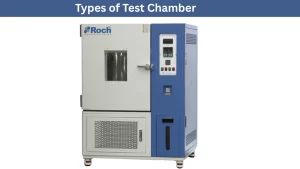
What is a Humidity Chamber?
A Humidity chamber is a type of environmental chamber designed to control and simulate specific humidity levels to test a product’s resistance, stability, and performance under varied humidity conditions. Humidity chambers are essential in industries like pharmaceuticals, electronics, automotive, and materials testing, where high humidity can affect product quality, functionality, and lifespan.
Uses of Humidity Chambers
- Product Durability Testing: Evaluates the long-term effects of humidity on products to ensure reliability in real-world environments.
- Quality Control: Ensures products meet industry standards for resistance to moisture, especially for sensitive components like electronics and metals.
- Material Testing: Assesses how materials such as plastics, metals, and coatings react to moisture exposure, helping prevent issues like corrosion or material degradation.
- Research & Development: Assists in the development of products by understanding how different materials and components perform under high humidity conditions.
- Pharmaceutical Stability Testing: Verifies that drugs maintain their efficacy and stability when exposed to high moisture, meeting regulatory standards for storage and usage.
Key Features of Humidity Chambers
- Precise Humidity Control: Typically provides a range from 10% to 98% relative humidity (RH) to simulate a variety of humid environments.
- Temperature Regulation: Often includes temperature control to test the combined effects of temperature and humidity, typically ranging from -70°C to 180°C.
- Digital Programmability: Equipped with programmable controllers for setting and automating complex humidity cycles over extended periods.
- Data Logging: Records humidity and temperature data in real-time, enabling detailed analysis of testing conditions and outcomes.
- Uniform Airflow: Maintains even distribution of temperature and humidity throughout the chamber to prevent localized variations.
- Observation Window: Allows users to monitor samples during testing without opening the chamber and disturbing the test environment.
- Safety Features: Includes alarms, overheat protection, and emergency shutdown systems to ensure safe operation.
- Corrosion-Resistant Interior: Built with materials that can withstand high humidity and prevent rusting or corrosion of the chamber itself.
Working Principle of a Humidity Chamber
Humidity Generation:
- The chamber includes a humidifier, typically steam-based or water spray, which increases the moisture level to achieve the desired relative humidity.
- A dehumidifying system reduces the moisture level as needed, often using desiccants or cooling coils that condense excess moisture.
Temperature Control:
- Heating and cooling elements work in tandem to maintain the target temperature within the chamber, as temperature significantly affects humidity levels.
- The temperature is continuously monitored, and the heating or cooling system adjusts to keep the environment stable.
Air Circulation:
- Fans within the chamber provide uniform air circulation to evenly distribute temperature and humidity.
- This airflow is crucial for maintaining consistent conditions throughout the testing area, preventing hot or cold spots that could lead to inaccurate results.
Automated Control System:
- The chamber’s digital control system allows for precise adjustments of both humidity and temperature, often with programmable cycles for complex testing protocols.
- Data from humidity and temperature sensors is monitored in real-time, with automatic adjustments made to maintain the specified conditions.
Data Logging and Monitoring:
- The chamber’s internal sensors continuously record environmental data, and this information can be logged and stored for later analysis.
- Most humidity chambers allow remote monitoring and data export for quality control and regulatory documentation.
Humidity Chamber Works
A humidity chamber works by carefully controlling and stabilizing both temperature and humidity levels to simulate specific environmental conditions. This simulation enables the testing of materials, components, and products under varying humidity to assess durability, reliability, and performance. Here’s a step-by-step breakdown of how a humidity chamber operates:
1. Humidity Generation and Control
- Humidifier: The chamber includes a humidification system, typically steam-based, that adds moisture to the chamber environment. The system may use a water reservoir with heaters to create steam or atomizers that release fine water particles to achieve the desired humidity level.
- Dehumidification System: To decrease humidity, many chambers have dehumidifiers, often utilizing desiccants or cooling coils to condense and remove moisture from the air. By adjusting these systems, the chamber can precisely regulate the humidity level to meet specific test parameters.
- Humidity Sensor: Built-in sensors measure the relative humidity (RH) in real-time. These sensors continuously monitor the RH and relay data to the control system, allowing precise adjustments to maintain the target humidity level.
2. Temperature Control
- Heating and Cooling Elements: Temperature plays a crucial role in humidity regulation, so humidity chambers are equipped with both heating and cooling systems. Heating elements are typically electric, while cooling is achieved with refrigerant-based systems. These systems can reach a wide range of temperatures, from very low to high, depending on the test requirements.
- Thermal Sensors: Temperature sensors inside the chamber monitor the internal temperature, ensuring it stays within the specified range. The control system uses these readings to adjust the heating or cooling as needed to maintain stable conditions.
3. Air Circulation and Uniformity
- Internal Fans: To ensure that temperature and humidity are evenly distributed, the chamber uses fans for consistent air circulation. This prevents localized variations (hot or cold spots) that could interfere with test results.
- Uniform Environment: Constant airflow ensures that each part of the chamber’s interior has a uniform temperature and humidity, critical for reliable and repeatable test results.
4. Automated Control System
- Programmable Controls: The control panel of the chamber allows operators to set specific test cycles with desired humidity, temperature, and duration. Many humidity chambers have digital or touchscreen controls, making it easy to create and automate complex test protocols.
- Real-Time Adjustments: The control system continuously monitors sensor data and makes automatic adjustments to humidity and temperature to keep conditions stable. For instance, if humidity drops below the target, the system activates the humidifier to increase moisture.
5. Data Logging and Monitoring
- Data Collection: Modern humidity chambers are equipped with data logging systems that record temperature, humidity, and other parameters over the test duration. This data is essential for analyzing product performance under controlled humidity levels.
- Monitoring and Alerts: Some chambers offer remote monitoring and send alerts if conditions deviate from set parameters. This feature is especially useful for tests running over long periods, as it ensures that the operator can take corrective actions if needed.
Summary of the Humidity Chamber Operation
Humidity chambers maintain specific environmental conditions by regulating humidity through humidification and dehumidification systems and controlling temperature with heating and cooling elements. The chamber’s control system, sensors, and fans work together to maintain a stable and uniform environment. Through programmable settings and data logging, the chamber provides accurate and reliable conditions for testing how products perform under various levels of humidity and temperature.
About Roch Mechatronics Inc.:
Roch Mechatronics Inc., located in Ghaziabad, Uttar Pradesh, is a leading manufacturer of Humidity Chamber. Renowned for our exceptional quality and client satisfaction, we specialize in Test Chamber, Environmental Chamber, Humidity Chamber and Walk-in Chamber. Our standout feature is our 24/7 customer support, ensuring you always have assistance when needed. For inquiries or support, call us at +91-7011654652 or email info@rochmechatronics.com, rochmechatronicsinc@gmail.com

